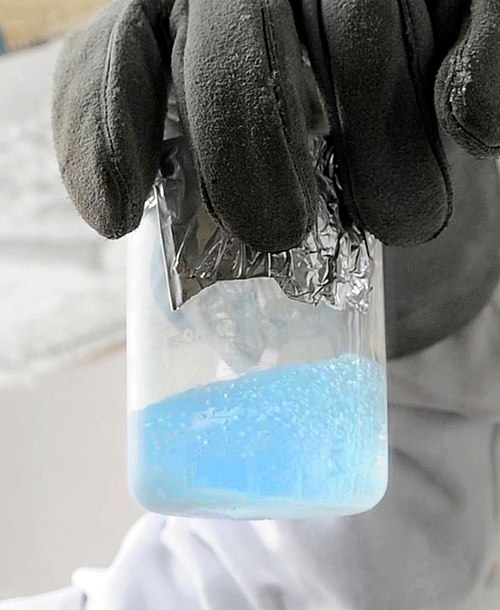Facts for Kids
Oxygen is a colorless and odorless gas that is essential for respiration in living organisms and plays a key role in various chemical processes.
Overview
Oxygen In Medicine
Properties Of Oxygen
The Discovery Of Oxygen
Oxygen In The Atmosphere
Industrial Uses Of Oxygen
The Role Of Oxygen In Life
Oxygen And Space Exploration
Environmental Impact Of Oxygen

Inside this Article
Carl Wilhelm Scheele
Cellular Respiration
Space Exploration
Carbon Dioxide
Atomic Number
Temperature
Atmosphere
Breathing
Energy
Did you know?
🌬️ Oxygen is essential for the process of respiration in most living organisms.
🌍 About 21% of Earth's atmosphere is composed of oxygen.
💧 Oxygen is a key component of water, which is crucial for all known forms of life.
🔥 Oxygen supports combustion, enabling fires to burn and energy to be released.
🌎 Oxygen was discovered in 1774 by the Swedish chemist Carl Wilhelm Scheele.
🔬 Oxygen is the most abundant element by mass in the Earth's crust.
🧪 In its gaseous form, oxygen is a colorless, odorless, and tasteless diatomic molecule (O2).
🌌 Oxygen is vital for the production of ATP, the energy currency of cells, during cellular respiration.
💨 Ozone (O3), a molecule made of three oxygen atoms, provides protection from harmful UV radiation in the atmosphere.
👃 Oxygen plays a crucial role in processes like oxidation and reduction, which are fundamental in both chemistry and biology.
Introduction
It is colorless and tasteless, which means you can’t see or taste it, but we breathe it every day! Oxygen makes up about 21% of the air around us. The element symbol for oxygen is "O," and it has an atomic number of 8. That means it has 8 protons in its nucleus! You can find oxygen everywhere: in the air, oceans, and even in our bodies. It helps plants grow and animals breathe, making it a key player on Earth! 🌱🐾
Oxygen In Medicine
People who have trouble breathing sometimes use "oxygen tanks," which give them extra oxygen to help them feel better. Hospitals use oxygen to treat patients with conditions like pneumonia or asthma. 🌬
️ It even plays a crucial role during surgeries to keep patients safe! In addition, oxygen therapy is used to heal wounds faster and is essential in emergency situations, helping doctors and nurses to provide fast care. Oxygen helps people fight illness and stay strong, making it a true hero in the medical world! 🦸
♀️
Properties Of Oxygen
️ This means it helps things burn, like when a candle flickers or a campfire blazes. When oxygen combines with other elements, it can create compounds, such as water (H₂O). Oxygen is also very light—it's about 1.4 times lighter than air! 💨
It can exist as a single atom (O) or as a molecule with two atoms (O₂), which is the form we breathe. Just think, without oxygen, nothing would be able to survive!
The Discovery Of Oxygen
Another scientist, Carl Wilhelm Scheele, also discovered oxygen but did it around the same time in Sweden. Later, Antoine Lavoisier, a French chemist, named it “oxygen,” which means “acid-former” in Greek because he thought it was important for making acids. Isn’t it amazing how different scientists contributed to finding this important gas? 👩
🔬👨🔬
Oxygen In The Atmosphere
The atmosphere is divided into five layers: troposphere, stratosphere, mesosphere, thermosphere, and exosphere. Most of the oxygen we breathe is in the troposphere, the closest layer to the ground. 🌬
️ Although it makes up only 21% of the atmosphere, that’s still enough for everyone to breathe! The other gases include nitrogen (78%) and tiny amounts of other gases. The presence of oxygen in the atmosphere is vital for weather and climate! ☀
️🌧️
Industrial Uses Of Oxygen
One of its most exciting roles is in welding, where it helps join metals together by using a flame. 🔥
It is also used to make steel, glass, and various chemicals. In the manufacturing process, pure oxygen is often combined with other gases to create energy and heat. Additionally, oxygen is essential for treating wastewater, which cleans up dirty water! These industries help create products we use every day and keep our environment healthy. So, you see, oxygen isn't just important for living things—it’s also a star in industry!
The Role Of Oxygen In Life
Animals and humans use oxygen to breathe and produce energy inside their bodies. During a process called cellular respiration, we take in oxygen and use it to change food into energy, releasing carbon dioxide in return. 🌬
️ Plants, on the other hand, take in carbon dioxide and use sunlight to produce oxygen during photosynthesis! This amazing balance is what keeps life thriving on Earth. Without oxygen, we wouldn't be able to live—just like plants need us to breathe out carbon dioxide.
Oxygen And Space Exploration
Astronauts need oxygen to breathe while they are in space, where there’s no air. Spaceships are equipped with special systems that supply oxygen to astronauts on their adventures. 🌌
When journeys are long, like trips to Mars, scientists must create ways to generate oxygen from water or plants! Additionally, rockets use liquid oxygen as fuel to launch into space. 🚀
This combination of science and oxygen is what allows humans to explore the universe, looking for new worlds and adventures beyond our planet! 🌠
Environmental Impact Of Oxygen
It comes from plants, especially trees, during photosynthesis. 🌞
As they grow, they produce oxygen and clean the air we breathe. However, humans and animals must do their part, too! When we breathe out, we create carbon dioxide, which plants need to create oxygen. 🌱
This natural cycle shows how oxygen supports all life on Earth. Sadly, pollution can damage this balance. So, it’s crucial for everyone to help keep the environment clean to ensure enough oxygen for years to come! 🌿

